Hello, I’m Michael Zhang. Over the years, I’ve explored historic landmarks around the world—from the Pyramids of Egypt to the Acropolis in Athens. Each site felt like a silent book carved in stone. But if you asked me which cultural icon in China rivals those wonders, I would answer without hesitation: the Leshan Giant Buddha.
Carved during the Tang Dynasty and completed over 90 years, this colossal cliffside statue is not only a symbol of Sichuan but also a pinnacle of ancient Chinese stone carving. In this guide, I’ll walk you through the rich history, cultural significance, and practical travel tips for visiting the Leshan Giant Buddha—so that you don’t just check it off your list, but truly understand its depth.
Summary
Leshan Giant Buddha Overview
The Leshan Giant Buddha, also known as Lingyun Giant Buddha, is officially titled the “Maitreya Stone Statue of Jiazhou Lingyun Temple.” This seated statue of Maitreya reaches a towering height of 71 meters, making it the largest stone Buddha carved into a cliff in China. Construction began in the first year of the Kaiyuan reign (713 AD) during the Tang Dynasty and was completed in the nineteenth year of Zhenyuan (803 AD), taking approximately 90 years. Now a 5A-rated scenic spot, the Leshan Giant Buddha, together with Mount Emei, is also recognized as a UNESCO World Heritage Site.
The Buddha’s head is level with the mountain top—14.7 meters high, 10 meters wide, with 1,051 coiled hair buns and 7-meter-long ears. The statue was carved directly into the cliff, facing the river in a commanding seated position that radiates solemn grandeur. On both sides of the Buddha, you’ll find two guardian kings standing over 16 meters tall carved into the cliff wall. On the Buddha’s right is the Nine-Bend Plank Road, a narrow winding path carved during the Tang Dynasty for both religious rituals and construction access. The steep, zigzagging path clings to the cliff, offering a dramatic and challenging descent.
- Address: No. 2435, Lingyun Road, Shizhong District, Leshan (Apple Maps / Amap)
- Opening hours:
- Peak season (Apr 1–Oct 7): 07:30–18:30
- Off-season (Oct 8–Mar 31): 08:00–17:30
- Recommended visit duration: 3 to 5 hours
- Best time to visit: All seasons
- VR tour: Click to Explore
- Ticket price: 80 CNY
- Ticket booking: Trip.com Discounts
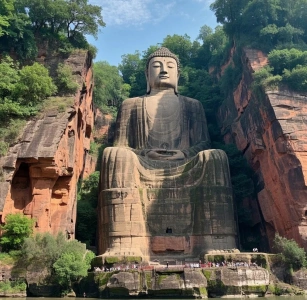
Leshan Giant Buddha Map
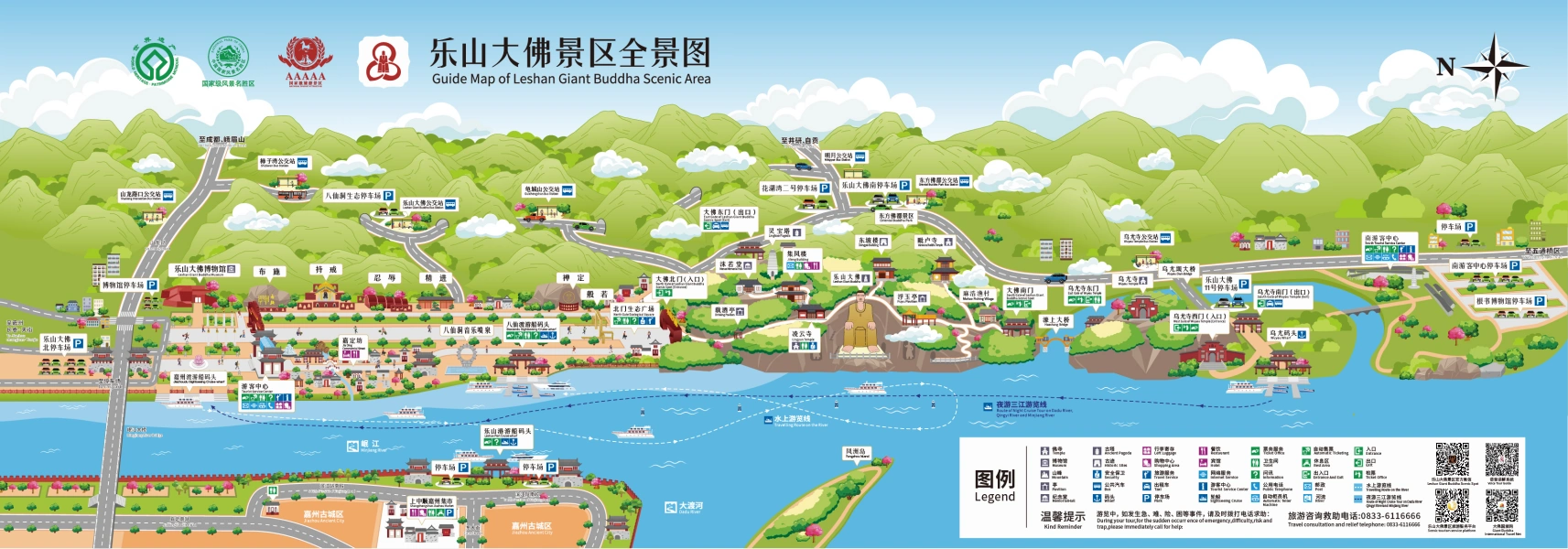
Why You Should Visit Leshan Giant Buddha
Profound Cultural Significance
Carved in 713 AD and completed in 803 AD, the Leshan Giant Buddha bears witness to the prosperity and transformation of ancient China. It serves as a vital physical artifact for studying the Tang Dynasty’s society, economy, culture, and religious practices. This immense Buddha, carved into the mountain and facing the confluence of three rivers, exemplifies both architectural brilliance and a deep reverence for Buddhist beliefs. From an artistic perspective, the statue demonstrates exquisite craftsmanship and lifelike detail, making it a cultural treasure that integrates art, history, and science in one monumental form.
Magnificent Natural Scenery
The Leshan Giant Buddha scenic area includes not only the Buddha itself, but also Lingyun Mountain and Wuyou Mountain, offering a rich variety of natural attractions. While exploring the statue, visitors are also treated to breathtaking views of the surrounding mountains and rivers. Moreover, a nighttime tour of the Leshan Giant Buddha provides a unique perspective—enhanced by soft lighting that casts dramatic shadows, revealing new dimensions of this ancient marvel.
Top Things to Do in Leshan Giant Buddha
Main Attractions
“Buddha” Calligraphy Carving
Among the many stone inscriptions in the Leshan Giant Buddha Scenic Area, none is more iconic than the “Buddha” character carved by Su Shi, a famous writer of the Northern Song Dynasty. Located on a cliff face below Lingyun Temple, the character is about 1.5 meters tall, bold and vigorous in style, and full of ancient charm. It perfectly reflects Su Shi’s calligraphic traits—expressive, powerful, and unrestrained. This carving is not only a treasure of Chinese calligraphy but also a symbol of spiritual heritage that has endured over a millennium. It represents the intellectuals’ deep respect for Buddhism and their philosophical reflections during that time.
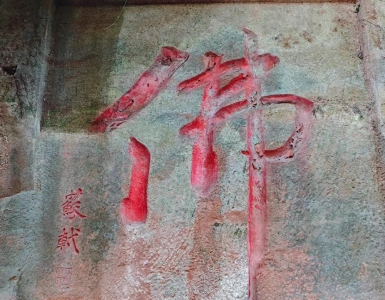
Lingyun Temple
Built during the Tang Dynasty, Lingyun Temple is part of the same Buddhist complex as the Leshan Giant Buddha. Originally called “Lingyan Temple,” it was later renamed based on its location on Lingyun Mountain. The temple is nestled on the mountain slope, surrounded by towering ancient trees, and is still an important spiritual center for the local community. After entering through the main gate, visitors can ascend the steps gradually, experiencing an increasingly solemn atmosphere of worship. Though the temple has undergone restoration, it still retains many architectural elements from the Ming and Qing dynasties, making it a prime example of traditional Chinese Buddhist architecture.
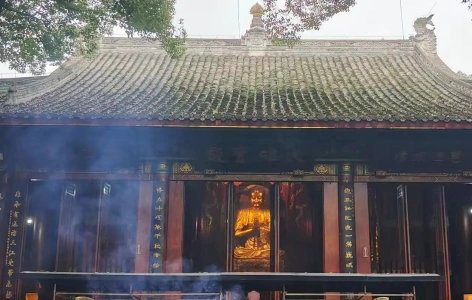
Lingyun Plank Road
Lingyun Plank Road, also known as the Nine-Bend Plank Road, is one of the main paths leading down to the feet of the Buddha. It was carved directly into the cliff during the Tang Dynasty as an access route for workers and pilgrims. Though reinforced in modern times, the road retains much of its original look. Walking along this narrow, winding path clinging to the cliffside allows visitors to view the Buddha’s face up close and enjoy sweeping views of the river below. However, the path is steep, so comfortable and non-slip shoes are highly recommended.
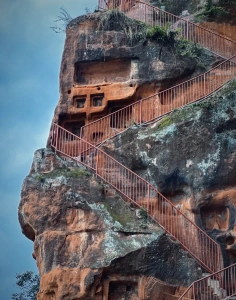
Leshan Giant Buddha
The Leshan Giant Buddha is the spiritual and visual centerpiece of the entire scenic area. This 71-meter-high seated Maitreya statue faces the river with a calm and serene expression, exuding awe-inspiring grandeur. It is not only a religious icon but also a monumental engineering achievement. The Buddha’s ears are 7 meters long, and its hands are large enough to seat multiple people side by side. These dimensions showcase the Tang Dynasty’s superb stone carving techniques. Particularly impressive is the ancient drainage system hidden within the statue—built into the hair, robe folds, and internal body—which has protected the Buddha from water erosion for centuries. It stands as a true testament to the engineering and spiritual wisdom of ancient China.
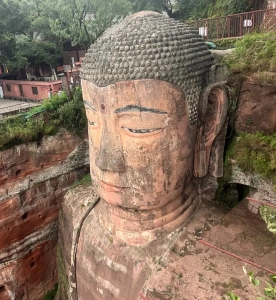
Leshan Giant Buddha Ticket Guide
Ticket Prices
- Adults: 80 CNY
- Children: 40 CNY, for ages 7 to under 18
- Students: 40 CNY, for full-time students up to undergraduate level
- Seniors: 40 CNY, for those aged 60 to 64 visiting during official Chinese holidays; free admission on non-holiday days
- Free admission: Children 1.2 meters or shorter (or 6 years old and under); seniors 65 and above; seniors 60–64 on non-holiday days
Where to Buy Tickets
- Online: WeChat public account, third-party travel platforms
- Ticket Purchase: Trip.com Discounts
- On-site: Tickets can also be purchased at the visitor center. If you plan to buy tickets in person, arrive early to ensure availability.
Recommended Hiking and Boat Routes at Leshan Giant Buddha
There are two main ways to explore the Leshan Giant Buddha: by hiking or by taking a sightseeing boat. You only need a ticket if you choose to hike, while boat rides do not require a scenic area admission ticket. Of course, you can do both. For first-time visitors who are physically able, hiking is highly recommended. Although boat rides are easier and offer a panoramic view of the Buddha from the river, the experience can be crowded when everyone rushes to the deck during the stop. That said, if hiking isn’t an option for you, the boat remains the best way to see the entire statue.
Hiking Route Guide
- Classic hiking route (about 2 hours): Enter via North Gate → Maitreya Cave → Su Shi’s “Buddha” calligraphy → Guanyin Cave → Hui Tou Shi An viewpoint → Confluence View Platform → Dragon Waterfall → Tiger Cave → Zai Jiu Pavilion → Lingyun Temple → Leshan Giant Buddha → Master Hai’s Cave → Buddha’s Feet → Moon Pavilion → Su Garden → Exit at East Gate
- If you want to take a boat after exiting the East Gate, hop on the sightseeing shuttle to Wuyou Dock.
Boat Tour Guide
- To go directly to the boat, set your navigation to “South Visitor Center.” The boat dock is at Wuyou Pier. If you start from another visitor center, take the sightseeing shuttle—it’s not within walking distance.
- Boat tour details:
- There are two main viewing points: the cliff-side inscription “中流砥柱” and the Leshan Giant Buddha itself
- The boat stops for 5 minutes in front of the Buddha, and staff will help you take photos. You’ll get a free 5-inch printed photo. An 8-inch HD version costs 30 CNY per print
- The same pier is used for both boarding and disembarking
- Ticket price: 70 CNY
- Boat ticket purchase: Click to Buy
Recommended Food Near Leshan Giant Buddha
There are plenty of small restaurants near the North Gate of the scenic area for a quick bite. However, if you’re looking to try authentic local cuisine, head to Zhongshun Food Street near Leshan Port—just a 15-minute taxi ride away. The entire street is lined with eateries offering delicious regional dishes.
Recommended Hotels Near Leshan Giant Buddha
Leshan is mainly known for two must-see attractions: the Leshan Giant Buddha and Mount Emei. Most visitors stay one night near Mount Emei and one to two nights in Leshan. For accommodation in Leshan, it’s best to stay near Shangzhongshun Street, the city’s most famous food street. It sits just across the river from the Leshan Giant Buddha and offers convenient access to both the high-speed rail station and major scenic spots.
Jiangshang Lingyun·Qingwan Hotel (Leshan Giant Buddha Zhanggongqiao Food Street)
.webp)
- Location: 2-minute walk from Shangzhongshun Food Street
- Price per night: from 138 CNY
- Check rates: Trip.com Specials
- Rating: Trip 9.4
- Special amenities: Laundry room, triple rooms, family-friendly rooms
The hotel boasts a great location with convenient transportation. Surrounded by food streets, rooms offer views of the Min River, with the Leshan Giant Buddha scenic area just across the water.
Clean rooms with comfortable pillows and beds. The bathroom and shower are thoughtfully separated. However, since it’s in a lively area, it can be noisy at night. Be sure to request a quieter room at check-in.
From a beautiful dream Hotel
.webp)
- Location: Located directly within Shangzhongshun Food Street
- Price per night: from 308 CNY
- Check rates: Trip.com Specials
- Rating: Trip 9.7
- Special amenities: Laundry room
Perfectly located in the heart of the food street—great atmosphere and surroundings. A taxi to Leshan Giant Buddha takes about 15 minutes.
Beautiful interior with a wabi-sabi design style and cozy bedding. Exceptionally clean with new facilities and a spotless bathtub. High water pressure. Excellent service. A great value-for-money choice.
How to Get from Leshan City Center to Leshan Giant Buddha
Most travelers arrive at Leshan by high-speed train and then transfer to the Leshan Giant Buddha scenic area. Below is a transportation guide from Leshan Railway Station to the site.
By Bus
After arriving at Leshan Railway Station, take bus K1 or 601 and get off at Jiadingfang Station (2 CNY). Walk about 500 meters to reach the North Visitor Center of the Leshan Giant Buddha. From there, take the scenic shuttle bus to the North Gate ticket checkpoint.
By Taxi or Ride-Hailing App
Taking a taxi from Leshan Railway Station to the Leshan Giant Buddha takes about 30 minutes and costs approximately 25 CNY.
How to Get from Chengdu to Leshan Giant Buddha
If you’re planning an independent trip, the easiest way is to take a high-speed train from Chengdu to Leshan, then transfer by bus to the scenic area. For families with children or seniors, consider joining a Chengdu day tour, which includes round-trip transportation and is much more convenient.
High-Speed Train + Bus
Start from Chengdu East Railway Station, take a high-speed train to Leshan Railway Station (approx. 55 minutes, 54 CNY), then transfer to bus K1 or 601 and get off at Jiadingfang Station (2 CNY). Walk 500 meters to the North Visitor Center, then take the scenic shuttle to the North Gate entrance.
- Train route: Chengdudong → Leshan
- Book train tickets: Click to Book
Day Tour or Private Car
There are many day tours from Chengdu that visit the Leshan Giant Buddha and nearby attractions. These typically include round-trip transportation. If you prefer to avoid walking or transferring between stations, this is a great choice.
FAQ
If you’re traveling with a stroller or wheelchair, the boat tour is the best option. It’s flat throughout, though you’ll need to be cautious when getting on and off the boat.
You can store luggage for free at the visitor center of the Leshan Giant Buddha. If you prefer to leave your luggage near the Leshan Railway Station, head to the bus station next to the station—there are free lockers and nearby shops offering paid storage services (10 CNY per item).

 English (US)
English (US)  English (Hong Kong)
English (Hong Kong)  English (Malaysia)
English (Malaysia)  English (Singapore)
English (Singapore)  繁體中文
繁體中文 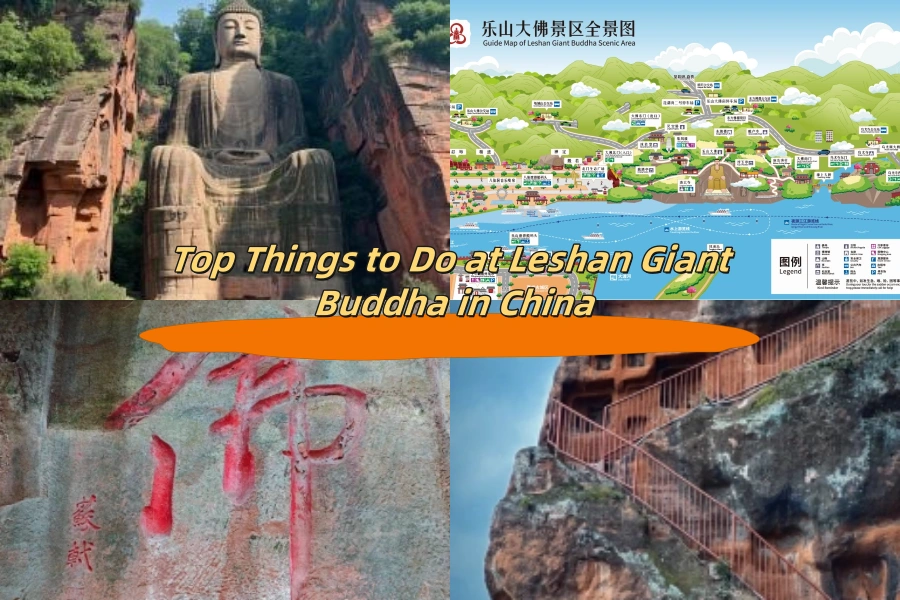
Comment (0)